PAST ISSUES
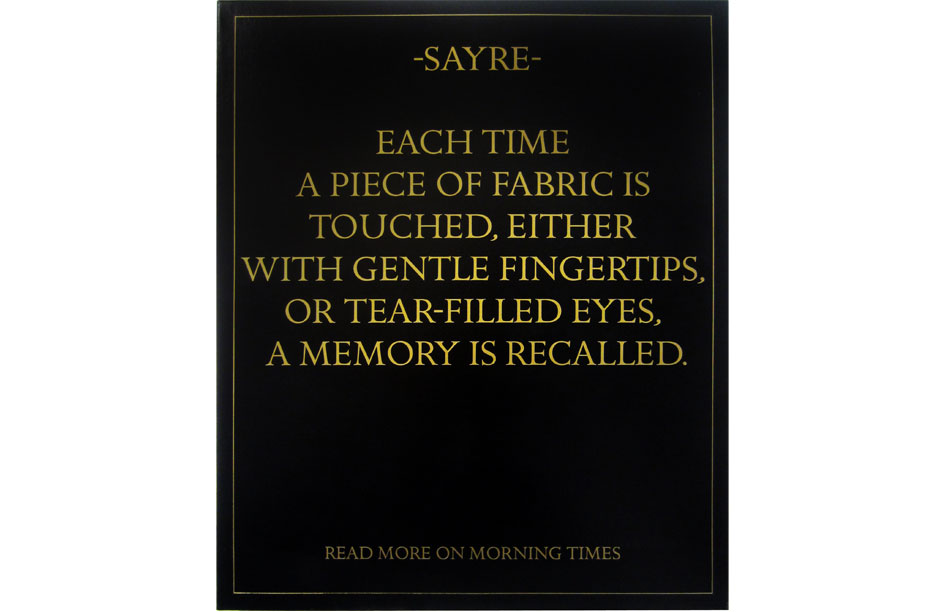 Sayre Gomez. "Clothed in Love", 2011. Oil on canvas. 36x36 inches. Courtesy of The Hole Gallery in New York.
Sayre Gomez. "Clothed in Love", 2011. Oil on canvas. 36x36 inches. Courtesy of The Hole Gallery in New York.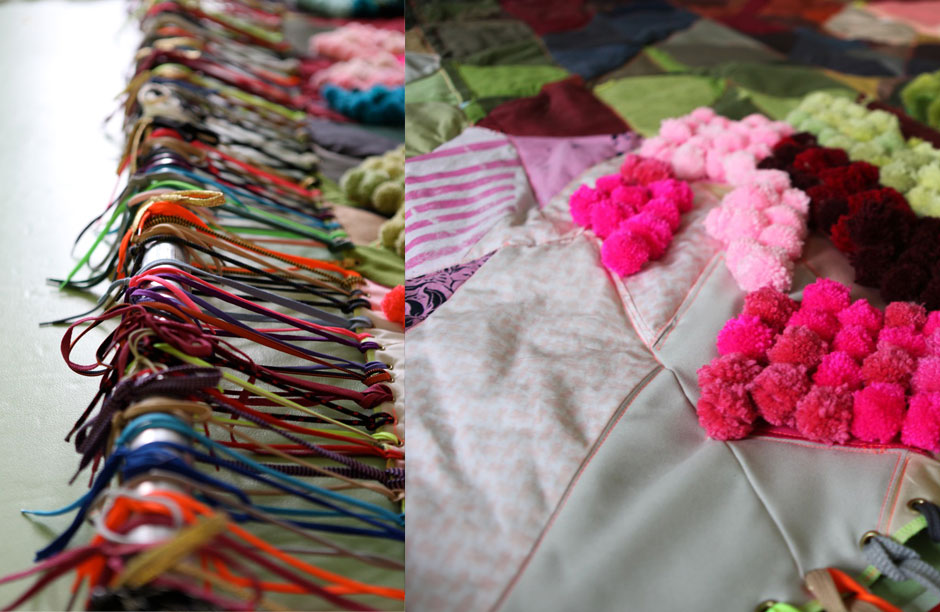 Details of a quilt commissioned as an elegy to Martin Cole a former Weiden + Kennedy ad executive. Created by the author, textile designer Dana Haim.
Details of a quilt commissioned as an elegy to Martin Cole a former Weiden + Kennedy ad executive. Created by the author, textile designer Dana Haim.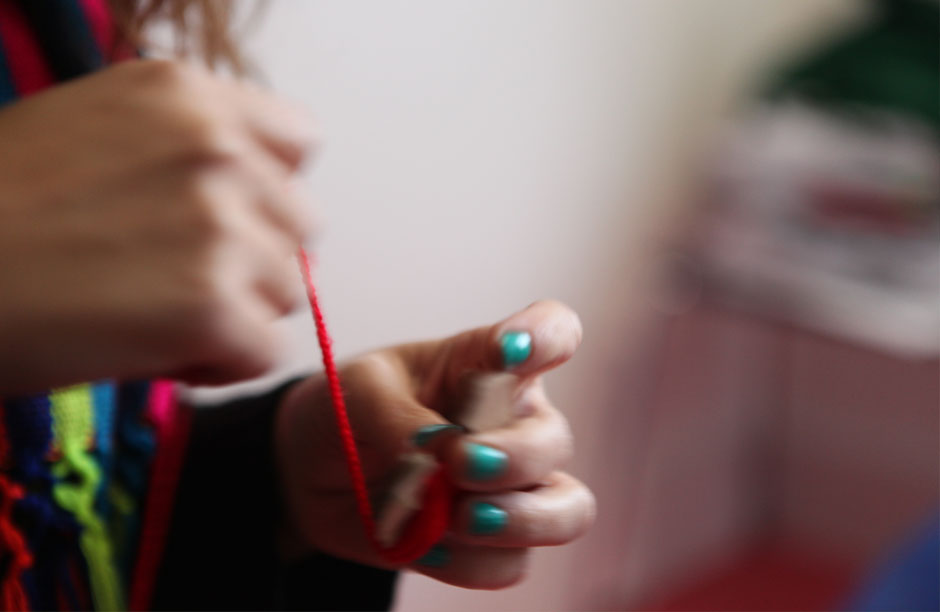
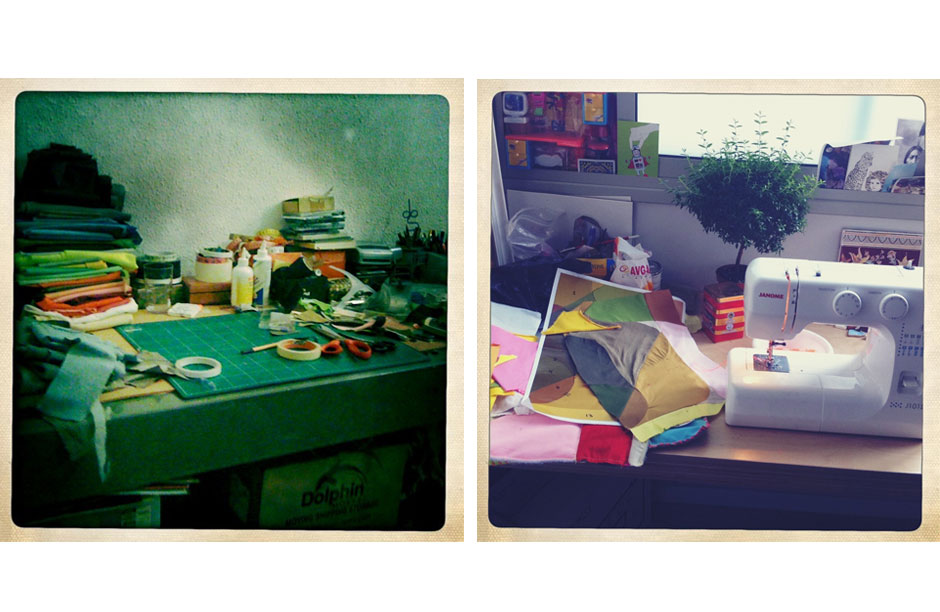 The author's workshop
The author's workshop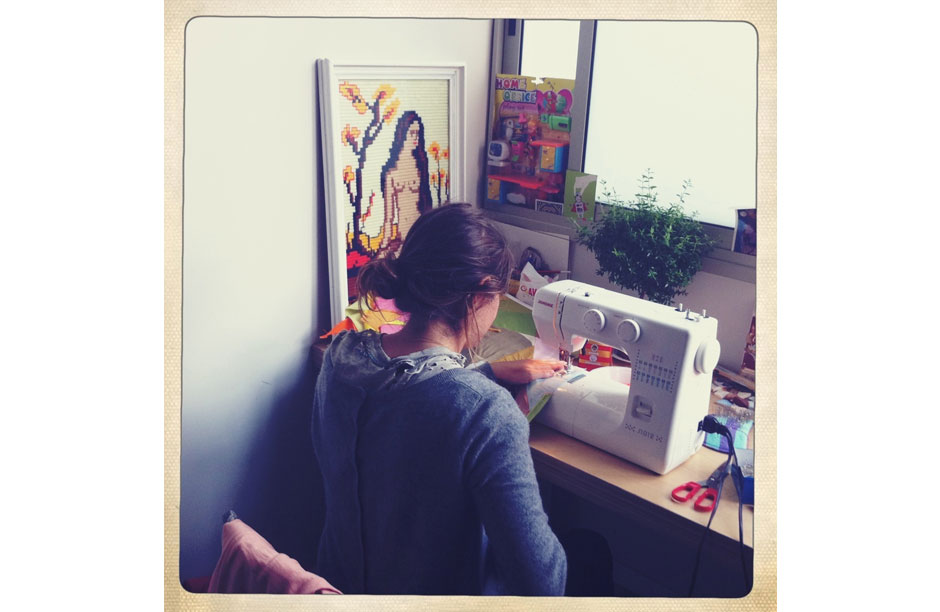 The author, textile designer Dana Haim, at work in her Tel Aviv apartment.
The author, textile designer Dana Haim, at work in her Tel Aviv apartment.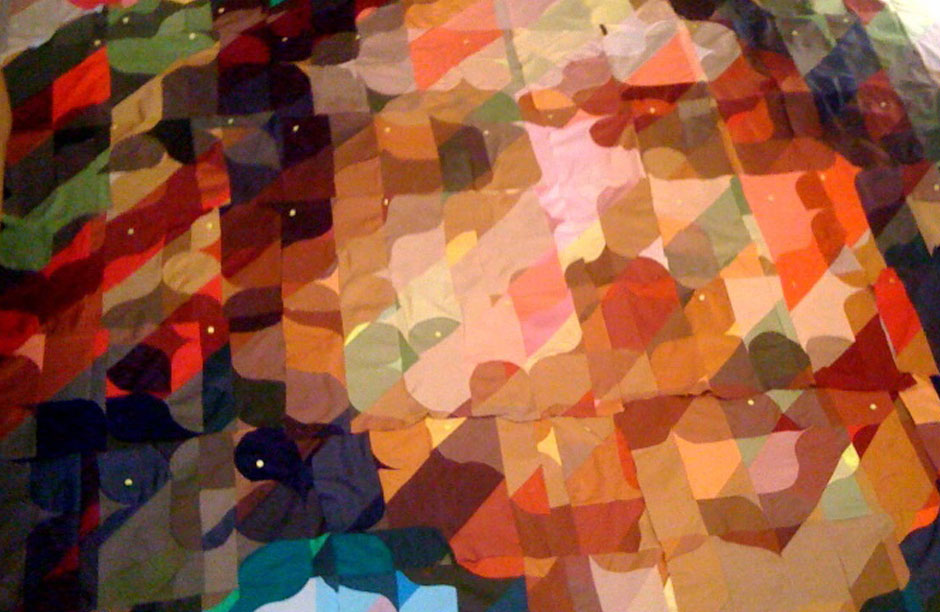 Details of the dozens of patches of clothing and cloth - the personal effects of Martin's - used to create his memorial.
Details of the dozens of patches of clothing and cloth - the personal effects of Martin's - used to create his memorial.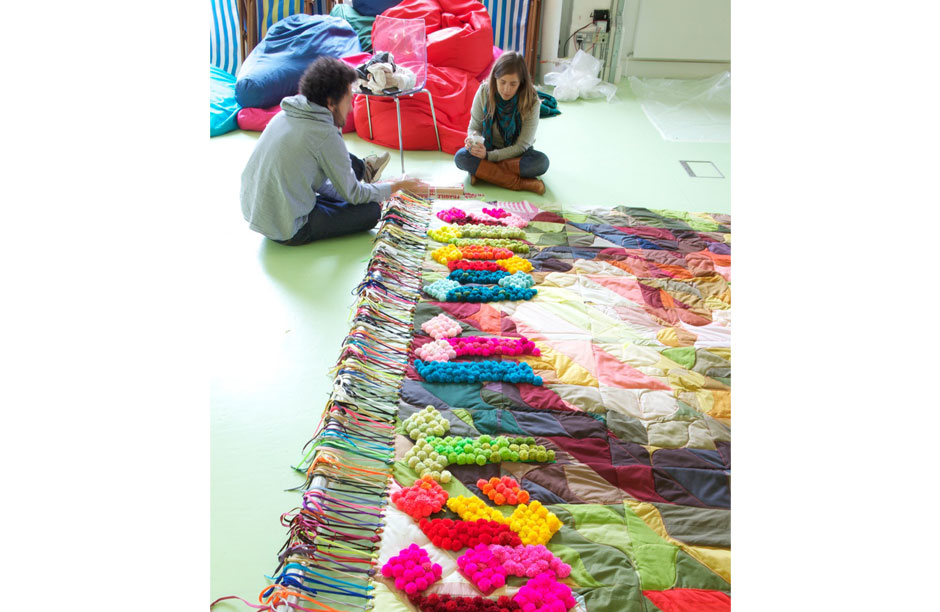 Dana and an assistant in London a few days before the unveiling of the quilt.
Dana and an assistant in London a few days before the unveiling of the quilt.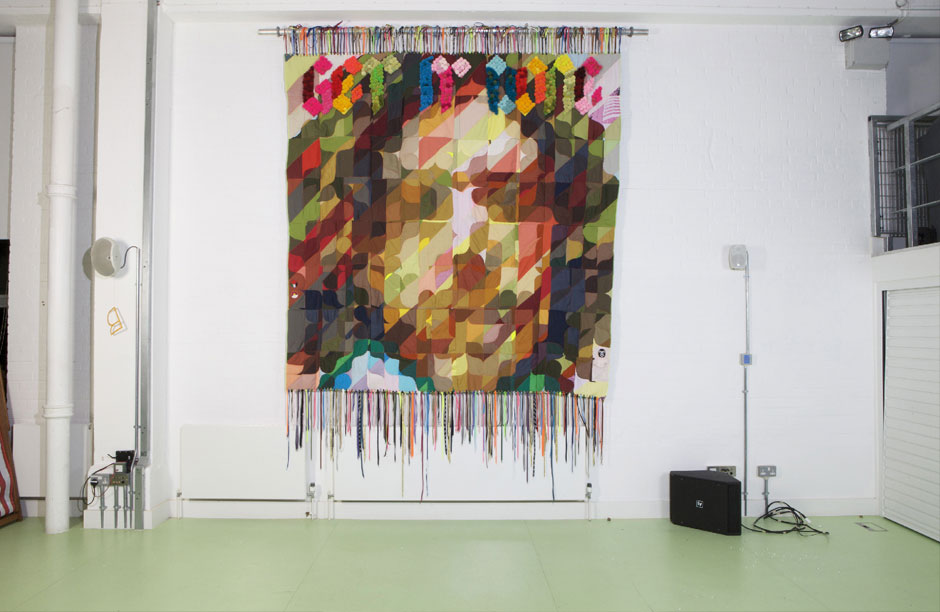 The finished piece before being installed in its permanent space at the Weiden + Kennedy offices in London.
The finished piece before being installed in its permanent space at the Weiden + Kennedy offices in London.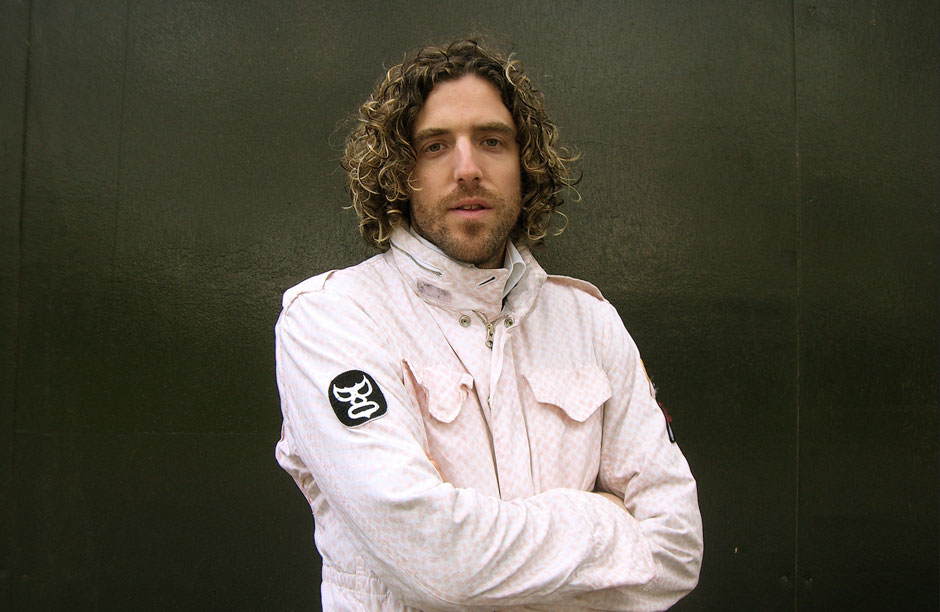 Martin Cole wearing a jacket the author was sent - part of the collection of his personal belongings she was given to interweave into the construction of his memorial quilt. (See 1st photo for a detailed patch of this jacket within the quilt).
Martin Cole wearing a jacket the author was sent - part of the collection of his personal belongings she was given to interweave into the construction of his memorial quilt. (See 1st photo for a detailed patch of this jacket within the quilt).
How Cloth Changed My Life
By Dana HaimI have always had a strange affinity towards fabric. Some of my earliest childhood memories consist of me holding a piece of plain white cotton cloth. I collected these pieces and became inseparable from them. I loved to feel the release when one string would quickly unravel the entire cloth. I loved to touch the different textures of the cotton – from the sharp pointy corners on my lips, to the strange holes that would take shape after long periods of time.
Then I remember turning 3 years old and being told it was time to let them go. My parents did not want me to become too attached to these blankets. I was forced to say good-bye to my treasured textiles. I think this sense of loss – which happened so early in my life – left me with an incomplete relationship to fabric that one day would inevitably need to be revisited.
As a teenager my innate, but suppressed fascination with fabric began to rise to the surface on subconscious levels. I became obsessed with fashion, clothes and expressing myself using textiles I wore. I would often find holes in all my t-shirts and jeans from ripping certain areas when I was nervous or bored. This was a seemingly obsessive behavior, but in hindsight I see that it was my intuition telling me what course my life would inevitably take.
So, just last year when tasked with constructing a memorial quilt out of the personal belongings of one very special individual, I found myself in my Tel Aviv apartment, rummaging through endless scraps of colored fabrics, mountains of old clothes, and collections of shoelaces. I had to stop and think about how my early obsession had led me to this point. Somehow, I felt destined to make this quilt; I felt a very strange connection to the person this memorial was for, though I had never met him. His stuff, his clothes, his textiles were so similar to things I wore and defined myself by – which may be why they chose me to do it. I reflected on the things we as individuals own, the fabrics we wear, the items we keep and how those things become embedded with our spirit and therefore take on a greater meaning.
The advertising company Wieden + Kennedy, best known for their “Just Do It” campaign for Nike, contacted me after seeing my work on the Central Saint Martins website, where I completed a Masters Degree in Design for Textile Futures in 2010. They told me they had sadly lost a colleague from their London office. His name was Martin Cole and everyone who knew him profoundly loved him. Tragically, Martin died of cancer at the young age of 33 leaving behind a lovely wife, Lotta, and a baby boy, Kasper.
I would never meet the man, but I spent three months of my life totally dedicated to him. Wieden + Kennedy commissioned me to create a 3-meter by 3-meter quilt as a memorial to Martin. Once I learned that we shared obsessions with craft, fashion, and music, it made sense to me why a quilt was the most fitting way to memorialize Martin. The design was to be a pixilated colorful image of his face crafted out of some of Martin’s clothes and personal items. I was to make the entire piece by hand from hundreds of pixels and shapes. Since Martin was constantly monitoring the sound levels in Wieden’s event space, they decided that it would aptly function as a sound buffer in that room, and would live there, forever.
The late Martin’s clothes took on a very special, enhanced meaning, as they became the very fabric for this memorial quilt made in his name. As I steamed the hood of his old, yellow sweatshirt, I could smell his scent. Even though I never met him. I got to know him on a deeper level from simply feeling the textures he chose, looking at the colors and patterns he liked, and smelling the smells that lingered on each garment that would fill the room whenever I ironed. I felt that he was with me, even though I was simply steaming his old t- shirts. Through this process, I felt like I knew him and, somehow, he knew me. As though we now share a cosmic link that goes far beyond fabric.
The challenge was that I had never made a quilt before, let alone something that had such emotional significance attached to it. I was determined to “Get it Done,” which I learned was the legacy that Martin left behind at Wieden’s, a phrase that would eventually be laid out in pompoms at the top of the quilt and that continues to resonate with me even after completing the piece.
I started by mapping the entire image into puzzle-like fragments. Once all the fabric was cut, I began the sewing process. I then flew to London where I made the final touches and created the shoelace fringe for hanging the quilt. Martin loved sneakers and had a collection of them, so we decided shoelaces would be a great way to finalize the piece. The last stage was a collaboration with some of Martin’s friends at Wieden’s. We made 1000 pompoms out of colorful wool, which we used to write out the slogan “Get it Done”.
When the quilt was complete they threw a party to unveil the project. Martin’s wife, son, and father attended the heart wrenching evening ceremony. When the curtain dropped and Martins face and all my work was revealed, my heart dropped with it. I felt an intense serge of both pride and sadness. I looked at Martins wife’s face when she saw his face in the quilt, and my eyes filled with tears as hers did as well. Martin’s family was so moved by the quilt and told me how happy they were that one day Martin’s son will be able to visit it and see how much his late father was appreciated by those who loved him. I hope he will be able to understand all the work that was put into the quilt, how much attention and love went into the whole process, all of it in honor of his dad.
Being a part of this project was so meaningful for me, knowing that I was able to channel my love for fabric into an object that not only memorializes a man in death, but also testifies to his greatness in life. The result made me realize a lesson in my own life. I realized that fabric is not simply a textile; there is greater meaning to the things we wear and surround ourselves with. Indeed, after we pass on, those items are often the only physical expressions of us left behind.
While working on Martin’s Memorial, I was forced to engage my inner child when having to tear up his old clothes. I relived the feelings I felt when I would break the fabrics, but this time there was a sadness attached to the unraveling. Making the Martin Cole Memorial Quilt made me acknowledge how everything eventually came full circle. My innocent obsession with old rags as a child may not have been so innocent after all. On some level, even as a child, I understood what I understand now. That Clothes are more than just pieces of cloth, they can also serve to express who we are as individuals.
